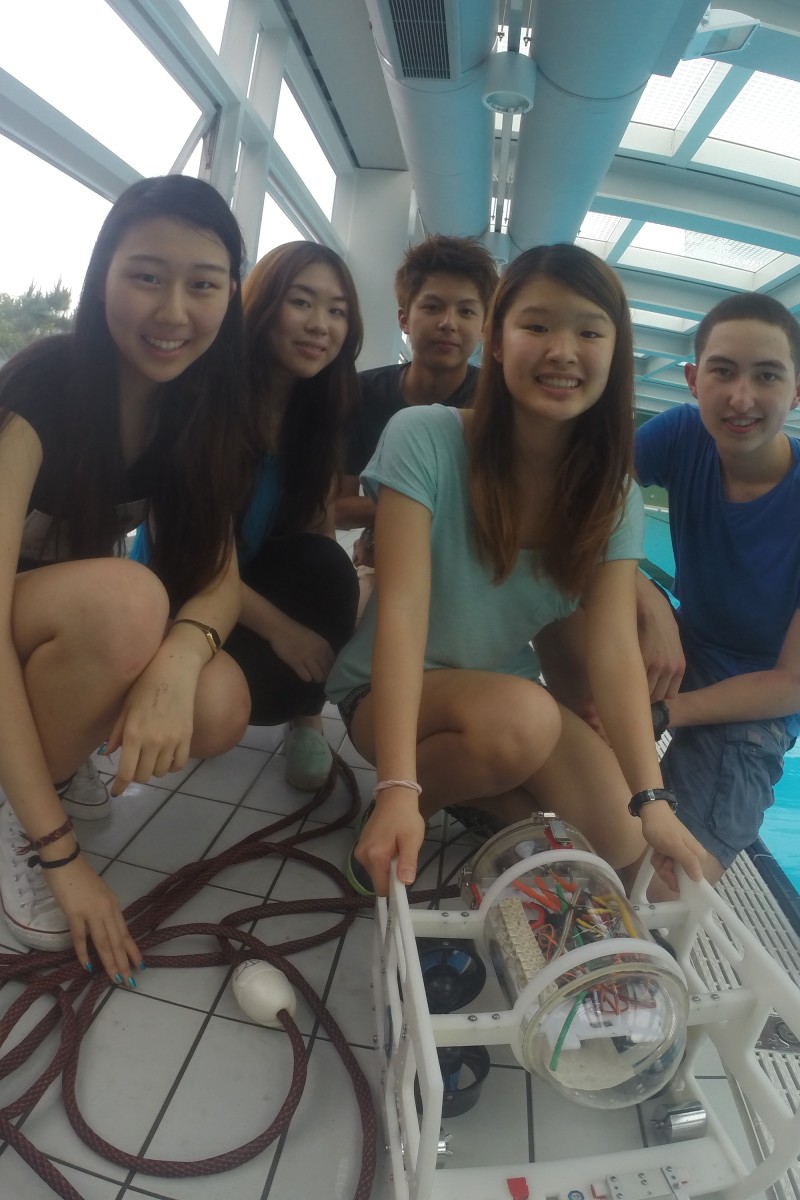 The GSIS team with their ROV: (from left) Hain Yoon, Cheryl Chan, Roger Lau, Maxine Kwan, Hugh Somerset and Matthew Zhang Xiao-chuan.
The GSIS team with their ROV: (from left) Hain Yoon, Cheryl Chan, Roger Lau, Maxine Kwan, Hugh Somerset and Matthew Zhang Xiao-chuan.Five of the six students that make up the Underwater Robotics Team at German Swiss International School (GSIS) huddle together next to the school swimming pool. Their small Remote Operated Vehicle (ROV) named Die Meduse – German for jellyfish – has sprung a leak, which is not good for an underwater robot.
As the team fiddle with the electrical elements on the robot and discuss different options for fixing the problem, 15-year-old team captain Hugh Somerset bursts through the doors, holding a glue that will hopefully provide at least a temporary solution to the problem.
The team is used to setbacks and challenges, and has overcome every obstacle in their path and won the Hong Kong Underwater Robot Challenge 2015 in April. Edging out schools from Hong Kong and the Asia region as well means the team now moves on to the international competition at the end of June, in Newfoundland, Canada.
Team engineer and chief financial officer, Maxine Kwan, age 16, says that the location in cold, northern Canada reflects the theme of this year’s competition. “Our theme this year is arctic exploration,” she says. “So we designed this robot specifically to help science under the ice.”
Team programmer Cheryl Chan, 17, adds that Die Meduse needs to complete specific missions in the competition, all in freezing water. “So it has to be able to withstand sub-zero temperatures,” she says, “because it’s got to perform under the ice.”
Roger Lau, age 15, explains that the tasks in the competition are based on real-life problems or tasks that robots might be needed to fix. “For example, you see we have a prop there,” he says gesturing to the pool. “That’s a pipeline. That would be like an off-shore pipeline, an oil pipeline. And we have to repair it, we have to cut it, retrieve it to the surface, replace ball heads.”
And the team needed to work together in order to design a robot that could do all of this and still stay within budget.
“So, one of the interesting things about our robot is actually we had the cheapest one,” says Cheryl. “In the competition, we had the lowest budget out of all the teams. And somehow we managed to win.”
With some teams spending as much as HK$100,000, the GSIS team kept their budget small, only spending HK$9,000. In order to keep their budget under HK$10,000, the team created a minimalist design that could still perform all the necessary tasks.
Hain Yoon, age 17, custom designed the outer casing, which was then laser cut from polypropylene. The design centred around one compact water-tight compartment and four thrusters which allow the robot to move up, down, left and right in the water. And of course, there’s a camera giving the team a live feed so they know where to send the bot Ö with their remote control.
“We wanted our robot to be super small, super fast, super light, super efficient,” explains Hugh. “You see robots [in the competition] with eight thrusters, we’ve got four thrusters. You see robots with four mechanical hands, we’ve got two hooks. You see robots that have multiple water-tight compartments to store all the electronics they have, we’ve got one main water-tight compartment. That’s the main design of the robot: we want it to be as small as possible.”
With the HK$12,000 prize money from winning the regional competition, the team is already upgrading their electric systems, hoping to make a splash at the international competition.
As Matthew Zhang Xiao-chuan, age 17, eases the now water-ready robot alongside him into the pool, the whole team holds their breath to see if their repair works. Swimming alongside it, Matthew gives the all-clear from the water as the little robot whirs to life.
The team knows the competition will be tough at the international level. “People who win once, generally win many, many times,” says Hugh. “So the top few contenders, the most competitive schools, are always the same.” But the team still thinks they have a good shot at the top 10: along with their minimalist robot, they have something else that sets apart from the competition. “Our team had the most girls at the regional competitions,” says Cheryl. The six members are evenly split by gender, with three boys and three girls. “We looked at past reports from the international competitions, most of them are male dominated. So that could be a good thing we’re bringing.”
And the team intends to get themselves noticed. “I think there will be about 50 teams in our class this time,” says Hugh. “Our goal is to go into the competition and scare them.”
